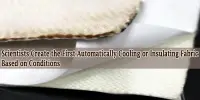Using ultra-fine nano-threads constructed partially of phase-change materials and other cutting-edge ingredients, textile technologists have created a fabric that can adapt to temperature changes by heating or cooling its wearer as necessary.
An improved textile with nanoscale threads that contain a phase-change substance in their core that can store and release a lot of heat when the material changes phase from liquid to solid has been created by materials scientists.
By combining the threads with coatings that improve the effect, such as electrothermal and photothermal coatings, they have essentially created a fabric that can swiftly cool the person down and warm them up as the weather changes.
A paper describing the manufacturing technique appeared in the American Chemical Society journal ACS Nano on August 10.
Many occupations, from firefighters to farmworkers, involve harsh hot or cold environments. Workers must frequently switch between various, occasionally harsh temperatures at cold storage facilities, ice rinks, steel forges, bakeries, and several other employment sites.
Such frequent variations in temperature are not only uncomfortable, but they can also result in disease or even injury and necessitate a laborious constant change of clothing. In a frigid meat locker, a sweater will keep a worker comfortable, but when they leave, they may become overheated.
Personal thermal management textiles are a new technology that can help those who are uncomfortable in the heat or cold, including travelers, athletes, and other people. These fabrics can directly manage the temperature of localized areas around the body.
Such fabrics often make use of phase-change materials (PCMs) that can store and later release large amounts of heat when the material changes phase (or state of matter, for example, from solid to liquid).
One such material is paraffin, which can in principle be incorporated into a textile material in different ways. The physical condition of paraffin shifts from solid to liquid, absorbing heat as a result, when the surrounding air exceeds its melting point. Then heat is released when the temperature reaches paraffin’s freezing point.
The problem here has been that the manufacturing methods for phase-change micro-capsules are complex and very costly. Worse still, this option offers insufficient flexibility for any realistically wearable application.
Hideaki Morikawa
Unfortunately, PCMs’ intrinsic stiffness in solid form and leakage while liquid have prevented their use in the field of wearable heat regulation thus far. A number of different strategies, including microencapsulation (in which the PCM such as paraffin is coated in extremely small capsules), have been attempted to improve the ‘packaging efficiency’ to overcome the rigidity and leakage problems.
“The problem here has been that the manufacturing methods for phase-change micro-capsules are complex and very costly,” said Hideaki Morikawa, corresponding author of the paper and an advanced textiles engineer with the Institute for Fiber Engineering at Shinshu University. “Worse still, this option offers insufficient flexibility for any realistically wearable application.”
So the researchers turned to an option called coaxial electrospinning. A technique for creating fibers with sizes on the order of nanometers is electrospinning. When a bulk reservoir, often a syringe with a needle tip, containing a polymer solution is linked to a high-voltage power source, an electric charge builds up on the liquid’s surface.
A very fine jet of the liquid is produced as soon as the electrostatic repulsion caused by the accumulated charge exceeds the surface tension. The electrostatic repulsion that caused the jet to form also causes it to lengthen as it dries in flight, and the resulting ultra-fine fiber is subsequently collected on a drum.
Similar processes, such as coaxial electrospinning, which produces coated or hollow nanofibers, involve two or more polymer solutions fed from nearby spinnerets. These core-and-sheath fibers are much, much smaller than coaxial cables that one may utilize for their stereo but have a comparable structure.
To prevent PCM leakage in this instance, the researchers enclosed the PCM in the electrospun nanofiber’s center. Additionally, the ultra-fine fibers enable an incredibly advantageous flexibility suitable for clothing for humans.
The researchers combined the PCM material with two other personal thermal regulation technologies to increase the number of work settings in which the textile would function and the accuracy of thermal control.
Combining photoresponsive materials materials that respond to the presence of solar radiation with PCMs may make it possible to increase the textile’s capacity for energy storage even more.
Additionally, if the worker finds themselves in cloudy, wet, or inside situations, coating the composite material with polymers that transform electricity into heat (an electrothermal conductive coating) can compensate for a similar increase of energy storage.
The researchers combined the three options PCMs, carbon nanotube and polydopamine solar absorbers, and electro-conductive polymers made of poly (3,4-ethylenedioxythiophene):polystyrenesulfonate (known as ‘PEDOT:PSS’) into a single ‘trimode’ thermoregulatory and wearable textile.
This multi-core and shell structure provides on-demand thermal management that can respond to a wide variety of external temperature fluctuations while enabling synergistic collaboration between its numerous components.
The goal of the researchers is to further enhance the fabric’s phase-transition capabilities and create wearable, useful uses for their product.
















